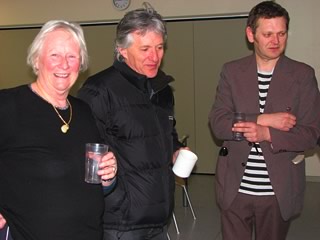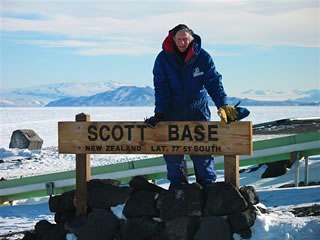Artists going south
By Tessa Duder
When I threw my hat in the ring for the 2007 Artists in Antarctica fellowship, I really thought it a long shot, with writers (Bernadette Hall and before her Laurence Fearnley) filling places in recent years. And I was, possibly, at the upper age limit.
However, a phone call in March 2007 informed me that the good folk at Antarctica New Zealand had chosen multi-media artist Ronnie van Hout and myself as the Arts Fellows from 40 applicants, along with oil painter John Walsh (author-illustrator of the picture book Nanny Mungo) as the Invited Fellow. Three months of the required secrecy followed – a tough call. We three would go in late October.
 |
Tessa with fellow Artists John Walsh, painter, and Ronnie van Hout, multi-media artist. |
My reading material for the next six months became almost exclusively the Heroic Age classics (Scott, Shackleton, Cherry-Garrard, Ponting et al), and the latest biographies challenging the infamous 1980s debunking publications stating that Scott was actually a bumbling idiot who led his men to destruction, and Shackleton the real hero who never lost a man.
Come September, there was a medical to get through; the toughest, said my doctor, in 30 years of doctoring, even worse than an airline pilot’s. (Two stress tests! The most complete blood tests, Mantoux test for TB, polio and tetanus shots! A questionnaire as long as your arm! Haemarrhoids, ma’am? It all took a whole week.) Two days before I was due to leave, to my extreme relief, the clearance came through and I got on the flight to Christchurch to spend a happy two nights staying with my good friend, author Joanna Orwin, and by day getting outfitted with proper clothing for The Ice.
The trio of Artists flew south with a bunch of Americans and much freight on a US Air Force Starlifter C-17, one of the world’s largest airplanes, its interior cavernous, windowless and naked. The trip took eight hours, and once over the ice we were invited to the ridiculously small cockpit to view the crazed and vast whiteness below. Landing (for us, with not a window to see out, blind) took two attempts, though we heard later it may have been for the benefit of the trainee pilot on board; at any rate, a costly exercise. Then, kitted out in our bulky ECWs, we stepped out into a – 20o C. haze, and driving across the vast expanse of sea ice towards Ross Island, through the bleak, treeless settlement that is the Americans’ McMurdo Station and 3 ks later, to the all-green Scott Base, fifty years old in 2007.
 |
Tessa with the famous Scott Base sign. |
Scott Base itself was fun – much like a typical Kiwi mountain hut, able to sleep 85, well run by interesting, multi-skilled people. It has quite a different culture from ‘Mactown’ with its Alaskan mining town appearance and shifting population of 1000, scientists and support staff. I had the chance to go with Ronnie and John to the Mactown Halloween party, but declined – somehow they didn’t mix for me, Antarctica and the largely-phoney festival that is Halloween. And I’d seen American international construction camps sufficiently up close and personal during my time as a young wife and mother in northern Pakistan in the late 1960s.
But we did later get to see something of the Crary Lab, the centrepiece of Mactown, indeed its raison d’etre, including the core of sea bed being drilled and retrieved (at the time, down to about 230 metres) about 15 ks away on the Ross Sea Ice. In a small room, the end result of the costly Andrill project was now laid out in long narrow trays, and we watched scientists from four countries jostle for the bits of the core they required for their research, all fascinating to a non-science person like me. The drill itself is apparently maintained in place by four huge air bags under the sea ice; we gathered, a particularly risky operation, as drilling rigs go. (You can read more about it by googling Andrill.) Sadly, the weather conspired against us visiting the Andrill site itself.
For me, long-time fascinated by the Heroic Age stories of Scott and others, the undoubted highlights were the activities connected with the great nearly 20th century explorers who operated from the Ross Sea and Ross Island area. First, we had to get to the historic huts; physically it was quite fun pretending I was 35 again and getting unaided into the Haaglunds (amphibious, tracked sea ice vehicles) and Toyota SUVs in very bulky and restricting extreme weather gear, especially when over-sized tyres put the Toyota’s cab well over a metre off the ground, with the Haaglund’s tracks even higher.
But the effort was of course every bit worth it – we visited the Scott ‘Discovery’ Hut at Hut Point close to Mactown and his ‘Terra Nova’ Hut at Cape Evans, two hours Haaglund journey north across the sea ice, following the western coast of Ross Island. Also the Shackleton ‘Nimrod’ Hut at the even more northerly Cape Royds. All three, despite bleak weather or possibly because of it, were awe-inspiring, sad, almost overwhelming experiences, and I learned much from chatting with the two Antarctic Heritage Trust conservators, an Australian and a Brit, currently working at Scott Base and at the huts themselves to restore, catalogue, photograph and secure the precincts and their artifacts for future visitors and posterity.
 |
Tessa on the top of Observation Hill, beside the cross erected in memory of Scott and his four companions, who reached the South Pole in March 1912 but died on the return journey. |
I also climbed with one of the Scott Base Field Trainers up to the Scott memorial cross atop the steep cone of Observation Hill (between Mactown and Scott Base), from where Scott and his men looked south early in 1902 and realized the magnitude of their quest to walk to the Pole many hundreds of miles beyond. Again, for me an unforgettable experience: the legend from Tennyson painfully inscribed on the vertical ‘body’ of the cross by those men nearly a hundred years ago is magnificent in its poignancy: ‘To strive, to seek, to find and not to yield.’ I have very vivid memories of hearing John Gielgud’s sonorous voice declaiming those lines on the 1950s recording of Vaughan Williams’ ‘Sinfonia Antartica,’ a symphony of music taken from the famous film Scott of the Antarctic starring John Mills.
 |
Tessa on field training, settling for sleep in a snow cave at -22 degrees C. |
The more personal challenges were unexpected. We knew we had to start with three days of field training, but didn’t expect to find ourselves deciding voluntarily to sleep in our snow cave (made by compacting snow onto a neat pile of gear, then extracting the gear and laboriously lowering the floor with small shovels from inside) rather than the tents we also had to put up with the ambient temperature at – 22o C. No wind, thankfully. John Walsh, painter but sometime deep sea trawlerman, is a real whizz with a shovel.
 |
Tessa standing at the doorway of the New Zealand A-frame hut on the Ross Ice Shelf used for field training. Behind is the sweep of Ross Island with Mt Erebus. |
Best of all was the opportunity to spend a night on my own in a little A-frame hut on the Ross Ice Shelf, with Erebus (50 ks away, and higher than Mt Cook) at my back, the steep coastline of Ross Island to the side and in front, all the flat white vastness of the Ross Ice Shelf and beyond, looking west and south, the backdrop of those fabled Antarctic ranges. Not a solitary soul closer than Scott Base 7 ks away. I read and meditated the sunlit night away, happy as a sandboy in a little hut with a cosy, shabby interior that was like every NZ bach or trampers’ hut you’ve ever been in. You may have noticed reference to the A-frame, Scott Base’s own ‘bach’, by the Rev Peter Beck speaking at Sir Edmund Hillary’s funeral about a memorable night spent there with Sir Ed. Certainly the inside of that little hut had a special feel and warmth to it, not just the heating supplied by the diesel-fuel heater. And outside, just that view alone brought home the magnitude of the task and the courage of those who walked into that great white unknown a hundred years ago.
There were inevitably disappointments in our short stay. Going relatively early in the summer gave us the amazing experience of the midnight sun, and the reality of being outdoors in temperatures of down to – 30o C. (and with the wind added, wind chill factors of – 55o C.) but not much of icebergs as such and the fabled wildlife of penguins, seals and orcas. High summer (January and early February) is the time for that; we were confined to seeing about four seals who’d popped up through holes in the sea ice and penguins only once and distantly, at the Adelie rookery at Cape Royd. Increasingly strict environmental concerns meant that we couldn’t climb down to the rookery, but could view only from about 200 metres away.
The same environmental concerns meant that visits to the spectacular Dry Valleys, enjoyed by previous Artists, are now not allowed, nor any helicopter flying during the weather we had; one science team had to wait for a week for their helicopter trip to set up camp and begin their work on Antarctic sea urchins at Cape Bird. And visiting the internationally famous Andrill site remained a tantalizing possibility only to be finally scuppered by the weather.
Tourist activity is not yet too obvious in this area, nor should it ever be, in my book. But having read lots and seen a number of videos, I came to the conclusion that if people want to see classic Antarctic scenery and wildlife, they are better to join the 81,000 others (yes, that’s right) who travelled to the Peninsula area from South America last year. There will be found icebergs, penguins, ice floes and spectacular mountain scenery in abundance. If it’s the history, then of course the three Historic Huts will remain a good reason for going to the Ross Sea area.
Our return was delayed six days by weather – the forecasters couldn’t guarantee the C-17 a window long enough to leave Christchurch, land safely, unload and reload within two hours for its usual 8-hour return trip – so I had a good rest, a chance to use the emails, read and start thinking about what book(s) might come of this experience.
I have huge respect for the histories recently published in New Zealand by Marcia Stenson (Illustrated History of Antarctica), by Margaret Andrew (Antarctica: the unfolding story), Margaret Mahy (The Riddle of the Frozen Phantom) and Janice Marriott (Thor’s Tale). Non-fiction and fiction, they have set a high benchmark.
Slowly, by them and others in Britain (notably Geraldine McCaughrean), the US (Madeleine L’Engle) and Australia (Hazel Edwards and Coral Tulloch), a body of Antarctic literature for young people is being established.
It’s quite a challenge, to add something worthy, and it’s my task for 2008.
Ps Google Antarctica New Zealand and the New Zealand Antarctic Heritage Trust for background information: two truly excellent websites






